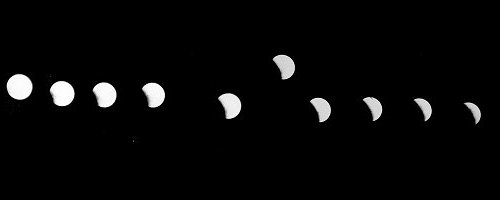

Day
Rise
Set
Rise
Set
1
9:07am
3:11pm
11:57am
10:56pm
15
8:53am
3:37pm
------
11:18am
30
8:24am
4:14pm
10:24am
11:19pm
Article as first published in The Shetland Times December 2000
Month one of year one of the third millennium AD and there is plenty to see in the night sky - if the clouds stay away.
|
|
|
|
|
|
|
Day |
Rise |
Set |
Rise |
Set |
|
1 |
9:07am |
3:11pm |
11:57am |
10:56pm |
|
15 |
8:53am |
3:37pm |
------ |
11:18am |
|
30 |
8:24am |
4:14pm |
10:24am |
11:19pm |
The first event that occurs this year you are not likely to notice.The Earth is at the closest point in its orbit to the Sun - called perihelion. This happens on the 3rd. However, the Northern Hemisphere is tilted away from the Sun so we have our winter although we are closer to the Sun than in summer.
The plane of the Earth's orbit around the Sun is known as the Ecliptic. All the other planets in the Solar System have their orbitreferred to the Ecliptic.
The second event this month is the Quatrandid meteor shower on the 4th of the month. The Moon will have set after midnight so an early morning session is required to catch this shower. Wrapping up warm will be essential.
The moon is full on the 9th and is new on the 24th. However, on the 9th the Earth eclipses the Moon. This is the only eclipse visible in Shetland this year.
The Moon can only be eclipsed at Full Moon but it does not occur at every Full Moon, as the Moons orbit around the Earth is inclined to the Ecliptic. Usually at Full Moon the Moon is above or below the Earth's shadow.

On the 9th the Moon rises at 2:58pm. During the eclipse it will be south of east at an altitude of about 35 degrees. The Earth's shadow touches the Moon at 6:43pm.It continues to eat into the Moon until it is fully enveloped at 7:51pm. The Moon will be in full shadow until 8:51pm. The eclipse continues until 9:58pm when the Moon leaves the Earth's shadow. Look out for the colour of the Moon during the eclipse.Photographers may like to try and record a multiple exposure as in the illustration, but try to avoid kicking the tripod half way through your series of photographs!
Some of the planets are well placed this month.
Jupiter and Saturn are still to be seen in Taurus near the Pleiades star cluster.
Mercury will be visible near the end of the month very low in the southwest sky.
Venus is in the evening sky not long after sunset. If you look low to the South you may be able to see Uranus in binoculars if you are lucky but it is getting nearer to the horizon as Venus climbs in to the evening sky.
Mars requires observing before the Sun rises and can be seen as the red 'star' just East of South before 7am. On the morning of the 18th the Moon will be just 5 degrees or half a fist at arms length, to the North of Mars.
Pluto and Neptune are too close to the Sun to be seen safely.